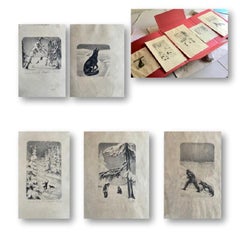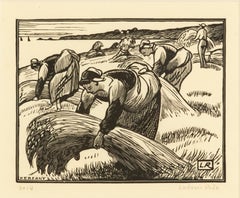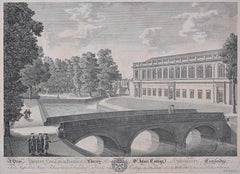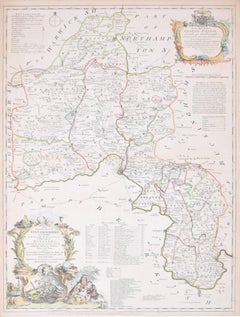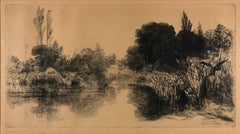Engraving Landscape Prints
to
460
834
272
120
42
8
Overall Width
to
Overall Height
to
250
101
96
87
29
10
8
7
6
4
2
2
1
46
24
22
21
18
437
290
474
99
8
22
66
61
71
32
11
46
17
27
249
778
476
16
691
344
252
244
172
129
117
85
84
82
82
80
80
67
66
63
62
62
49
49
6,590
3,570
2,659
1,404
1,300
149
244
856
305
Medium: Engraving
"Peter and the Wolf" - Wolf series with human figure
Located in Miami, FL
Mexican Artists of russian origin, was married to Diego Rivera from 1911 to 1921, the series for sale are illustrations for book, “Peter and the Wolf...
Category
20th Century Modern Engraving Landscape Prints
Materials
Paper, Engraving
Kerfany by Ludovic-Rodo Pissarro - Wood engraving
Located in London, GB
Kerfany by Ludovic-Rodo Pissarro (1878-1952)
Wood engraving
10.9 x 13.9 cm (4 ¹/₄ x 5 ¹/₂ inches)
Initialled and titled in the plate
Signed lower right, ...
Category
20th Century Post-Impressionist Engraving Landscape Prints
Materials
Engraving
Trinity College and John's College, Cambridge engraving by P S Lamborn
Located in London, GB
To see our other views of Oxford and Cambridge, scroll down to "More from this Seller" and below it click on "See all from this Seller" - or send us a message if you cannot find the ...
Category
18th Century Engraving Landscape Prints
Materials
Engraving
Map of Oxfordshire coloured 18th century engraving by Thomas Kitchin
Located in London, GB
To see our other original maps, scroll down to "More from this Seller" and below it click on "See all from this Seller" - or send us a message if you cannot find the poster you want....
Category
1760s Engraving Landscape Prints
Materials
Engraving
Monastery of St. Augustine, Canterbury /// William Dugdale Monasticon Anglicanum
Located in Saint Augustine, FL
Artist: Sir William Dugdale (English, 1605-1686)
Title: "Monastery of St. Augustine, Canterbury"
Portfolio: Monasticon Anglicanum: A History of the Abbies and Other Monasteries, Hosp...
Category
1810s Old Masters Engraving Landscape Prints
Materials
Engraving
Shere Mill Pond
Located in Missouri, MO
Shere Mill Pond, No. II (large plate). 1860. Etching and drypoint. Schneiderman 37.v/ix. 7 x 13 1/8 (sheet 10 3/4 x 16 3/8). This state is prior to publication in Études à l'Eau-Forte. Illustrated: Keppel The Golden Age of Engraving; Print Collector's Quarterly 1 (1911): 18; : Guichard, British Etchers, 1850-1940. A rich, brilliant proof with drypoint burr printed on white laid paper. Signed in pencil.
-------------------------------------------------------------------------------------------
Shere Mill Pond, No. II was one of the most highly praised landscape prints of the etching revival. An impression was exhibited at the Royal Academy in 1861 under Haden’s pseudonym, H. Dean. Francis Seymour Haden used this anagram of his own name early in his career as an artist, in order to retain his anonymity and preserve his professional reputation as a surgeon.
Biography:
Sir Francis Seymour Haden (16 September 1818 - 1 June 1910), was an English surgeon, best known as an etcher.
He was born in London, his father, Charles Thomas Haden, being a well-known doctor and lover of music. He was educated at Derby School, Christ's Hospital, and University College, London, and also studied at the Sorbonne, Paris, where he took his degree in 1840. He was admitted as a member of the College of Surgeons in London in 1842.
In 1843-1844, with his friends Duval, Le Cannes and Colonel Guibout, he travelled in Italy and made his first sketches from nature. Haden attended no art school and had no art teachers, but between 1845 and 1848 he studied portfolios of prints belonging to a second-hand dealer named Love, who had a shop in Bunhill Row, the old Quaker quarter of London. Arranging the prints in chronological order, he studied the works of the great original engravers, Albrecht Dürer, Lucas van Leyden and Rembrandt. These studies, besides influencing his original work, led to his important monograph on the etched work of Rembrandt. By lecture and book, and with the aid of the memorable exhibition at the Burlington Fine Arts Club in 1877, he tried to give a true reflection of Rembrandt's work, giving a nobler idea of the master's mind by taking away from the list of his works many dull and unseemly plates that had long been included in the lists. His reasons were founded upon the results of a study of the master's works in chronological order, and are clearly expressed in his monograph, The Etched Work of Rembrandt critically reconsidered, privately printed in 1877, and in The Etched Work of Rembrandt True and False (1895).
Haden's printmaking was invigorated by his much younger brother-in-law, James Whistler, at the Haden home in Sloane Street in 1855. A press was installed there and for a while Haden and Whistler collaborated on a series of etchings of the Thames. The relationship and project did not last.
Haden followed the art of original etching with such vigour that he became not only the foremost British exponent of that art but brought about its revival in England. His strenuous efforts and perseverance, aided by the secretarial ability of Sir WR Drake, resulted in the foundation of the Royal Society of Painter-Etchers and Engravers. As president he ruled the society with a strong hand from its first beginnings in 1880.
Notwithstanding his study of the old masters of his art, Haden's own plates were very individual, and are particularly noticeable for a fine original treatment of landscape subjects, free and open in line, clear and well divided in mass, and full of a noble and dignified style of his own. Even when working from a picture his personality dominates the plate, as for example in the large plate he etched after J.M.W. Turner's "Calais Pier," which is a classical example of what interpretative work can do in black and white. Of his original plates, more than 250 in number, one of the most notable was the large "Breaking up of the Agamemnon."
An early plate, rare and most beautiful, is "Thames Fisherman". "Mytton Hall" is broad in treatment, and a fine rendering of a shady avenue of yew trees leading to an old manor-house in sunlight. "Sub Tegmine" was etched in Greenwich Park in 1859; and "Early Morning--Richmond", full of the poetry and freshness of the hour, was done, according to Haden, actually at sunrise. One of the rarest and most beautiful of his plates is "A By-Road in Tipperary"; "Combe Bottom" is another; and "Shere Mill Pond" (both the small study and the larger plate), "Sunset in Ireland," "Penton Hook," "Grim Spain" and "Evening Fishing, Longparish," are also notable examples of his genius. A catalogue of his works was begun by Sir William Drake and completed by Harrington in 1880. During later years Haden began to practise the sister art...
Category
Late 19th Century Old Masters Engraving Landscape Prints
Materials
Drypoint, Etching
Whitehaven, Cumbria engraving by Elizabeth Byrne after Joseph Farington RA
Located in London, GB
To see more, scroll down to "More from this Seller" and below it click on "See all from this Seller."
Elizabeth Byrne (1777 - 1849) after Joseph Farington RA (1747 - 1821)
North View of Whitehaven, Cumbria
Hand-coloured engraving
27.5 x 56.5 cm
A view of the cliffs and port of Whitehaven in Cumbria.
Joseph Farington RA was an 18th-century English landscape painter and diarist. He drew a north and south view of Whitehaven, which were engraved by Elizabeth Byrne in the early 19th century. Byrne was a London-born etcher and landscape painter, who was taught by her father, the etcher William Byrne...
Category
1810s Realist Engraving Landscape Prints
Materials
Engraving
Castle (University College, Durham) engraving after Samuel and Nathaniel Buck
Located in London, GB
To see more, scroll down to "More from this Seller" and below it click on "See all from this Seller."
after Samuel Buck (1696 - 1779) and Nathaniel Buck (active 1724 - 1759)
View of Durham Castle...
Category
Late 18th Century Engraving Landscape Prints
Materials
Engraving
Oriel College, Oxford 18th century engraving from the Oxford Almanac
Located in London, GB
To see our other views of Oxford and Cambridge, scroll down to "More from this Seller" and below it click on "See all from this Seller" - or send us a message if you cannot find the ...
Category
18th Century Engraving Landscape Prints
Materials
Engraving
Oxford Christ Church and Carfax 18th century engraving by John Donowell
Located in London, GB
To see our other views of Oxford and Cambridge, scroll down to "More from this Seller" and below it click on "See all from this Seller" - or send us a message if you cannot find the ...
Category
1750s Engraving Landscape Prints
Materials
Engraving
View of Greenwich and Down the River engraving by Stadler after Farington
Located in London, GB
Joseph Constantine Stadler (1755 - 1828) after Joseph Farington (1747 - 1821)
View of Greenwich and Down the River (1795)
Hand-coloured engraving
23 x 3...
Category
18th Century Engraving Landscape Prints
Materials
Engraving
Theodoor Galle Martin de Vos 17th Century Engraving Jesus Faces the Sanhedrin
Located in London, GB
We have the full series of 52 prints (including title page) from Vita Passio et Resurrectio Iesu Christi listed. To find the others scroll down to "More from this Seller" and below it click on "See all from this Seller" and search for 'Collaert' - or message us as they may not all have been uploaded yet.
Theodoor Galle...
Category
17th Century Realist Engraving Landscape Prints
Materials
Engraving
Theodoor Galle Martin de Vos 17th Century engraving The Widow's Mite (Offering)
Located in London, GB
We have the full series of 52 prints (including title page) from Vita Passio et Resurrectio Iesu Christi listed. To find the others scroll down to "More from this Seller" and below i...
Category
17th Century Realist Engraving Landscape Prints
Materials
Engraving
Theodoor Galle Martin de Vos 17th Century Engraving Jesus Nailed to the Cross
Located in London, GB
We have the full series of 52 prints (including title page) from Vita Passio et Resurrectio Iesu Christi listed. To find the others scroll down to "More from this Seller" and below it click on "See all from this Seller" and search for 'Collaert' - or message us as they may not all have been uploaded yet.
Theodoor Galle (1571 – 1633) after Maerten de Vos (1532 - 1603)
Jesus is Nailed to the Cross
46. Et postquam venerunt in locum qui voctur Caluarie, ibi crucifixerunt eum. Luc. 23.
From Vita, Passio, et Resurrectio Iesu Christi first published 1598, this a later edition published by Joannes Galle (1600-1676)
17.5x22cm
From the Gospel of Luke, chapter 3 "When they came to the place called the Skull, they crucified him there."
Theodoor Galle was the son of Philip Galle...
Category
17th Century Realist Engraving Landscape Prints
Materials
Engraving
Theodoor Galle 17th Century Engraving Suffer the Little Children Martin de Vos
Located in London, GB
We have the full series of 52 prints (including title page) from Vita Passio et Resurrectio Iesu Christi listed. To find the others scroll down to "More from this Seller" and below it click on "See all from this Seller" and search for 'Collaert' - or message us as they may not all have been uploaded yet.
Theodoor Galle (1571 – 1633), Iacob de Bye (1581-1640) after Maerten de Vos (1532 - 1603)
29. Sinite paruulos, et nolite eos prohibere ad me venire : talium est enim reguum coelorum 19.
Engraving
From Vita, Passio, et Resurrectio Iesu Christi first published 1598, this a later edition published by Joannes Galle (1600-1676)
16.5x21.8cm
Hand-finished black wooden frame available
From the Gospel of Matthew, chapter 19 "Suffer the little children...
Category
17th Century Realist Engraving Landscape Prints
Materials
Engraving
Adrian Collaert Martin de Vos 17th Century Engraving Samaritan Woman at the Well
Located in London, GB
We have the full series of 52 prints (including title page) from Vita Passio et Resurrectio Iesu Christi listed. To find the others scroll down to "More from this Seller" and below i...
Category
17th Century Realist Engraving Landscape Prints
Materials
Engraving
"Torksey Hall" and "Newark Castle" from "Buck's Antiquities" /// Architecture UK
Located in Saint Augustine, FL
Artist: Samuel and Nathaniel Buck (English, 1696-1779) and (?-1759/1774)
Title: "Torksey Hall" (Plate 179) and "Newark Castle" (Plate 226)
Portfolio: Buck's Antiquities or Venerable ...
Category
1720s Old Masters Engraving Landscape Prints
Materials
Intaglio, Engraving, Laid Paper
David Loggan Wadham College Oxford Collegium Wadhamense 1675 engraving
By David Loggan
Located in London, GB
To see our other views of Oxford and Cambridge, scroll down to "More from this Seller" and below it click on "See all from this Seller" - or send us a message if you cannot find the view you want.
David Loggan (1634-1692)
Wadham College...
Category
1670s Realist Engraving Landscape Prints
Materials
Engraving
David Loggan St John's College Oxford Canterbury Quad engraving 1675
By David Loggan
Located in London, GB
David Loggan (1634-1692)
St John's College Oxford - Canterbury Quad
Engraving 1675
31x50cm
Baptised in Danzig in 1634 Loggan's parents were English and Scottish. Studying engraving in Danzig with Willem Hondius (1598-1652 or 1658) he moved to London in the late 1650s producing the engraved title-page for the folio 1662 Book of Common Prayer. Marrying in 1663 he moved to Nuffield, Oxfordshire in 1665 to avoid the Plague and was in 1668/9 appointed Public Sculptor to the nearby University of Oxford having been commissioned to produce bird’s-eye views of all the Oxford Colleges. He lived in Holywell Street as he did this. Oxonia illustrata was published in 1675, with the help of Robert White (1645-1704). Following its completion he commenced work on his equivalent work for Cambridge, Cantabrigia Illustrata which was finally published in 1690 when he was made engraver to Cambridge University.
Oxonia illustrata also includes an engraving of Winchester College (sharing its founder – William of Wykeham – with New College) whilst Cantabrigia illustrata includes one of Eton College (which shares its founder – Henry VIII – with King’s College).
Bird’s-eye views required a particular talent as an architectural perspectivist of that era as it was not until 1783 that the first living thing (a sheep, named Montauciel ‘climb to the sky’) was sent aloft by the Mongolfier brothers in a balloon. Loggan thus had to rely on his imagination in conceiving the views.
Loggan’s views constitute the first accurate depictions of the two Universities, in many ways unchanged today. Whilst the Oxford engravings were produced in reasonable numbers and ran to a second edition (on thicker paper and with a plate number in the bottom right-hand corner), those of Cambridge were printed in smaller numbers and no second edition was produced.
The Dutchman Pieter van der Aa published some miniature versions of the engravings for James Beverell’s guidebook to the UK Les Delices de la Grande Bretagne c. 1708.
Edmund Hort New (1871-1931) produced a series of pen-and-ink drawings of views of Oxford that paid homage to Loggan showing the development of the city in the following two hundred years. They were turned into photoengravings by Emery Walker...
Category
1670s Realist Engraving Landscape Prints
Materials
Engraving
New College, Oxford, engraving, 1690 David Loggan
By David Loggan
Located in London, GB
To see our other views of Oxford and Cambridge, scroll down to "More from this Seller" and below it click on "See all from this seller" - or send us a message if you cannot find the view you want.
David Loggan (1634-1692)
New College...
Category
1690s Realist Engraving Landscape Prints
Materials
Engraving
Lake
Located in New York, NY
Michele Zalopany was born in Detroit, Michigan. She attended the Columbus College of Art and Design from 1973 to 1974 and the Cleveland Institute of Art from 1976 to 1978. She earned her Bachelor of Fine Arts degree from the School of Visual Arts in 1981. Through her labor-intensive mezzotints, Zalopany employs realism to depict fictitious scenes, bearing witness to the disintegration of what was once the fulcrum of the American economy in Detroit.
Zalopany’s work is widely represented in many public and private collections in the United States and in Europe including The National Gallery of Art, The Yokohama Museum of Art, The Whitney Museum of American Art, The Walker Art Center, The Museum of Fine Art in Boston, The Cleveland Museum of Art, The Royal College of Art in London, and numerous others. Her work has been exhibited in galleries that include P.P.O.W., John Good...
Category
1990s Contemporary Engraving Landscape Prints
Materials
Mezzotint
$400 Sale Price
20% Off
Two Women by a River by Paulémile Pissarro - Wood Engraving
Located in London, GB
SOLD UNFRAMED
Two Women by a River by Paulémile Pissarro (1884 - 1972)
Wood engraving
12.5 x 17.3 cm (4 ⅞ x 6 ¾ inches)
Signed lower left, Paulémile - Pissarro and numbered lower r...
Category
20th Century Impressionist Engraving Landscape Prints
Materials
Wood, Engraving
Paysage à Asquins by Paulémile Pissarro - Wood Engraving Print
Located in London, GB
SOLD UNFRAMED
Paysage à Asquins by Paulémile Pissarro (1884 - 1972)
Wood engraving
9.7 x 15.5 cm (3 ⁷/₈ x 6 ¹/₈ inches)
Signed lower right, Paulémile-Pissarro, titled and numbered ...
Category
20th Century Engraving Landscape Prints
Materials
Wood, Engraving
Impressions of Italy - Italian Views
Located in London, GB
This complete set of fifty etchings, aquatints and drypoints are each hand signed by the artist "Edgar Chahine" at the lower left margins.
The folio was printed by A. Routy, Paris and published by Sagot, Paris in 1906.
The justification page is additionally hand signed in ink by the artist “Edgar Chahine” and the paper type is handwritten “Hollande”.
The impression is numbered in ink from the edition of 75 on the justification page. Each of the 50 plates are hand numbered in pencil to reflect their sequence and refers to the titles on the justification page.
Note: In 1906 the Fiancé of Chahine Mary Jacobsen died and the artist lost all love for life. His friend and publisher Sagot send him to Venice, Umbria and Toscana for distraction. Edgard Chahine returned with a sensitive group of etchings from the Italian countryside.
Literature: "Edgar Chahine: Catalogue de l'Oeuvre Grave", by M.R. Tabanelli, Published by IL Mercante de Stampe editeur, Milano, 1977.
Reference: Tabanelli 180-229.
Condition: Very good condition. The etchings, aquatints and drypoints in very good condition and printing with burr. The support pages and justification page with foxing staining. The folio cover...
Category
Early 1900s Engraving Landscape Prints
Materials
Drypoint, Etching, Aquatint
La Rue Porte au Berges, Caen
Located in London, GB
Stanley Anderson
1884-1966
Drypoint, signed out of the image bottom centre
Image size: 9 x 11 inches (22.8 x 28 cm)
Acid free mount
Alfred Charles Stanley Anderson CBE RA was a Brit...
Category
20th Century Engraving Landscape Prints
Materials
Drypoint
Les Deux Chaumieres
Located in New York, NY
Jean-Emile Laboureur (1877-1943), Les Deux Chaumieres, 1927-28, etching and engraving, signed in pencil lower left and numbered lower right. Laboureur 356, second state (of 4). One o...
Category
1920s Post-Impressionist Engraving Landscape Prints
Materials
Engraving, Etching
Le 14-Juillet au Village
Located in New York, NY
Jean-Emile Laboureur (1877-1943), Le 14-Juillet au Village, engraving and roulette, 1925, signed in pencil lower left and numbered lower right (30/100) [also initialed and dated in t...
Category
1920s Cubist Engraving Landscape Prints
Materials
Engraving
Aux Approches de Madrid (also Aux Abords de la Ville)
Located in New York, NY
Adolphe-Marie Beaufrere (1876-1960), Aux Approches de Madrid (also Aux Abords de la Ville), drypoint, 1927, signed and numbered (14/55), from the edition of 55, with the blindstamp of Sagot, publisher (Lugt 2254). Reference: Morane 27-19. In good condition, on very thin cream Japan paper, 6 1/2 x 9, the sheet 8 3/8 x 11 1/4 inches, archival matting.
A fine impression, with the drypoint burr extremely rich and effective (due in part to the use of a Japan paper, which tends to diffuse the ink surrounding the drypoint lines).
Beaufrere was born at Quimperle, in Brittany, and though he traveled widely he re-connected with this area throughout his life. As a teenager he decided that he wanted to become an artist and he traveled to Paris where, shortly after his arrival, he encountered the eminent Gustave Moreau, who took him on as a student. Moreau encouraged him to study old master prints, especially the prints of Rembrandt and Durer, which were available in the Cabinet des Estampes in Paris – this was to be critical in his development.
Beaufrere began printmaking in about 1904, with some woodcuts, but soon got into etching and engraving. Curiously, one of his colleague/teachers at the time was the Canadian etcher Donald Shaw MacLaughlan. He began showing his prints, with some success, but after his marriage in 1905, and with the urging of his new wife, moved out of Paris and back to Brittany. This move had a mixed effect on his career – contacts with other artists became fewer, but he did maintain gallery relationships, and the French countryside and it’s inhabitants would provide a continuing source of inspiration.
During the Great War Beaufrere served in the infantry, and had few opportunities to make art. But he did study a volume of Rembrandt’s prints...
Category
1920s Modern Engraving Landscape Prints
Materials
Drypoint
The Avon on the Road to Bexhill
Located in New York, NY
Theodore Roussel (1847-1926), The Avon on the Road to Bexhill, drypoint, 1919, signed in pencil and dated (15.7.19) lower left [also signed in the plate]. Reference: Hausberg 115, f...
Category
1910s Impressionist Engraving Landscape Prints
Materials
Drypoint
The Gate, Chelsea
Located in New York, NY
Theodore Roussel (1847-1926), The Gate, Chelsea; etching and drypoint, 1889-1890, signed on the tab and inscribed imp [also signed in the plate lowere right]. Reference: Hausberg 33, fourth state (of 4), from the total printing of about 43 impressions. In excellent condition, trimmed by the artist all around on the plate mark except for the tab, 8 1/8 x 6 1/2 inches.
A fine impression, printed on a light cream wove paper with plate tone (wiped to brighten the gate and doorway area) and substantial burr in the drypoint work.
According to Hausberg, “The gate and house behind it still stand today at No. 4 Cheyne Walk...
Category
1880s Impressionist Engraving Landscape Prints
Materials
Drypoint, Etching
The Brooklyn Bridge
By Rudolph Ruzicka
Located in New York, NY
Born in Bohemia in what is now the Czech Republic, Rudolph Ruzicka emigrated to the United States when he was ten years old. His family settled in Chicago, where Ruzicka worked as a ...
Category
20th Century American Realist Engraving Landscape Prints
Materials
Engraving
The Rape of Europa
Located in New York, NY
A very good impression of this scarce engraving with strong contrasts.
Catalogue reference: Bartsch 109
Category
16th Century Italian School Engraving Landscape Prints
Materials
Engraving
A set of Biblical prints after the Dutch painter and engraver Gerard Hoet
By Gerard Hoet
Located in London, GB
The present collection is a set of 131 prints after Gerard Hoet, the Dutch golden age painter and engraver, depicting various biblical scenes. Hoet was a leading artist in the Classicizing Dutch Academic style, and his work is defined by history paintings, with a particular interest in mythological, classical, historical, and biblical scene, in particular Old testament scenes...
Category
Early 1700s Academic Engraving Landscape Prints
Materials
Paper, Ink, Black and White, Engraving
$11,275 Sale Price
30% Off
Dark Hill River
Located in Palo Alto, CA
The Sacramento River deltas and levees near Thiebaud’s studio became a source of inspiration starting in the mid-1990s where he would sketch en plein air and then work combined ideas...
Category
Early 2000s Modern Engraving Landscape Prints
Materials
Engraving, Drypoint, Aquatint
Price Upon Request
Hill River
Located in Palo Alto, CA
Created in 2002, this Wayne Thiebaud Hill River, 2002 drypoint and aquatint in color on wove paper is hand signed by Wayne Thiebaud (Mesa, 1920 - Sacramento, 2021) in pencil in the l...
Category
Early 2000s Modern Engraving Landscape Prints
Materials
Drypoint, Aquatint
Price Upon Request
River Turns
Located in Laguna Beach, CA
Wayne Thiebaud has long been recognized as one of America’s most prominent modern artists. Probably best known for his straightforward, deadpan still-life paintings of the 1960s, and...
Category
21st Century and Contemporary Pop Art Engraving Landscape Prints
Materials
Drypoint, Etching
Price Upon Request
Heart Ridge
Located in Laguna Beach, CA
The images in Wayne Thiebaud's drypoints fill the space around them, carving into it. They are images of mountains. In one, only the mountaintop shows and a gigantic cloud is in the ...
Category
21st Century and Contemporary Contemporary Engraving Landscape Prints
Materials
Drypoint, Etching
Price Upon Request
Boston
Located in Missouri, MO
John William Hill (1812-1879)
"Boston" 1857
Hand-Colored Engraving
Site Size: 29 x 41 inches
Framed Size: 39 x 52 inches
Born in London, England, John William Hill came to America with his family at age 7. His father, John Hill, was a well-known landscape painter, engraver, and aquatintist. John William had a career of two phases, a city topographer-engraver and then, the leading pre-Rafaelite school painter in this country. Employed by the New York Geological Survey and then by Smith Brothers...
Category
1850s Pre-Raphaelite Engraving Landscape Prints
Materials
Engraving, Aquatint
Price Upon Request
Quarter of Nine, Saturday's Children.
By Martin Lewis
Located in Storrs, CT
Quarter of Nine, Saturday's Children. 1929. Drypoint. McCarron 78. 9 3/4 x 12 3/4 (sheet 12 7/8 x 17 7/8). Illustrated: American Etchers: Martin Lewis. Edition 107. A fine impression...
Category
1920s American Modern Engraving Landscape Prints
Materials
Drypoint, Etching
Price Upon Request
Driving Home in the Rain
Located in Storrs, CT
Driving Home in the Rain. 1914. Drypoint. Appleby 35. 7 3/8 x 10 1/8 (sheet 12 x 15 3/8). Edition 40. Illustrated: Guichard, British Etchers, 1850-1940; Print Collector's Quarterly 1...
Category
1910s Modern Engraving Landscape Prints
Materials
Drypoint
Price Upon Request
Engraving landscape prints for sale on 1stDibs.
Find a wide variety of authentic Engraving landscape prints available on 1stDibs. While artists have worked in this medium across a range of time periods, art made with this material during the 21st Century is especially popular. If you’re looking to add landscape prints created with this material to introduce a provocative pop of color and texture to an otherwise neutral space in your home, the works available on 1stDibs include elements of blue, orange, purple, yellow and other colors. There are many well-known artists whose body of work includes ceramic sculptures. Popular artists on 1stDibs associated with pieces like this include David Loggan, Adriaen Collaert, David Lucas, and Salvador Dalí. Frequently made by artists working in the Modern, Contemporary, all of these pieces for sale are unique and many will draw the attention of guests in your home. Not every interior allows for large Engraving landscape prints, so small editions measuring 0.01 inches across are also available
